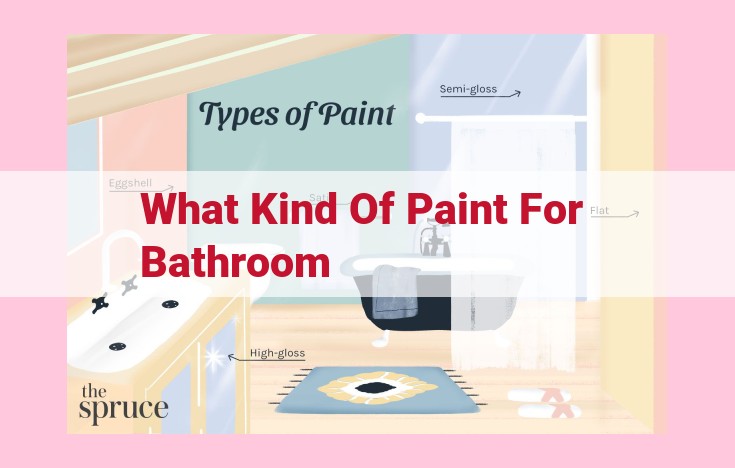Essential Bathroom Painting Guide: Moisture-Resistant Paints, Durable Finishes, And Perfect Preparation

For bathrooms, moisture-resistant and anti-mold paints are essential. Semi-gloss or gloss paints provide durability against steam and humidity, while vapor-barrier paints prevent moisture damage. Ensure bathroom surfaces are well-prepared before painting by cleaning, sanding, and priming. Use high-quality brushes and rollers specifically designed for bathroom surfaces. Protect surrounding areas with drop cloths and wear safety gear for a successful painting experience.
Bathroom Paint Options: A Guide to Choosing the Perfect Finish
When it comes to painting your bathroom, the right paint choice is crucial for both durability and moisture resistance. Bathrooms are exposed to high levels of humidity, steam, and potential mold and mildew growth, making it essential to choose a paint that can withstand these conditions.
Various types of paint are specially designed for bathrooms, each offering unique features and benefits:
- Mold- and Mildew-Resistant Paints: These paints contain additives that inhibit mold and mildew growth, making them ideal for humid bathroom environments.
- Semi-Gloss or Gloss Paints: These paints have a higher sheen level, which makes them more durable and resistant to moisture. They are also easier to clean and wipe down.
- Vapor-Barrier Paints: These paints create a vapor barrier on the surface, preventing moisture from seeping into the wall or ceiling and causing damage.
When selecting a bathroom paint, consider the specific features of each type and choose one that best suits your needs and the condition of your bathroom surfaces.
Mastering Bathroom Surface Preparation for a Flawless Paint Job
When it comes to bathroom renovations, painting plays a crucial role in enhancing the aesthetics and protecting the vulnerable surfaces. To achieve a stunning and durable finish, meticulous surface preparation is essential. In this comprehensive guide, we’ll delve into the different bathroom surfaces and provide step-by-step instructions on how to prepare them flawlessly.
Deciphering Bathroom Surfaces
Bathrooms encompass an array of surfaces, each with its own unique characteristics. Understanding these surfaces is key to selecting the appropriate preparation methods.
- Tiles: Ceramic and porcelain tiles are nonporous and moisture-resistant, making them ideal for bathrooms. However, they may require additional preparation for optimal paint adhesion.
- Drywall: Unlike tiles, drywall is porous and susceptible to moisture damage. To ensure a long-lasting finish, proper sealing and priming is essential.
- Wood: While less common in bathrooms, wood surfaces require specific preparation to prevent warping and rot due to moisture.
Step-by-Step Surface Preparation
Once you’ve identified the bathroom surfaces, follow these step-by-step instructions for impeccable preparation:
1. Deep Cleaning:
Begin by thoroughly cleaning the surfaces using a strong detergent solution. Remove all dirt, grease, and soap scum for maximum paint adhesion.
2. Sanding for Smoothness:
For unpainted tiles or uneven drywall, sanding is essential. Use fine-grit sandpaper to smooth out imperfections and create a surface that paint can adhere to.
3. Addressing Problematic Surfaces:
- Mold and Mildew: If mold or mildew is present, treat it with a specialized cleaning solution before painting. Neglecting this crucial step can compromise the paint’s performance.
- Uneven Texture: For drywall, apply a thin layer of spackling paste to fill in holes and smooth out uneven surfaces.
4. Essential Priming:
Primer acts as a barrier between the surface and the paint, enhancing adhesion and preventing moisture damage. Choose a primer specifically designed for the type of surface you’re painting.
Remember, each surface preparation method should be tailored to the specific characteristics of the bathroom surfaces. By following these guidelines, you’ll create a solid foundation for a beautiful and long-lasting bathroom paint job.
Essential Painting Tools and Supplies for Bathroom Renovations
Embarking on a bathroom painting project requires not only the perfect paint but also the right tools and supplies. Navigating the vast array of options can be daunting, especially for novice painters. This comprehensive guide will provide you with all the essential items to ensure a flawless and long-lasting paint job in your bathrooms.
Brushes and Rollers: The Heart of Your Painting Arsenal
The choice of brushes and rollers plays a crucial role in achieving a smooth, even finish. For bathroom surfaces, opt for high-quality synthetic brushes and rollers specifically designed for use in humid environments. These brushes and rollers are resistant to moisture and mold, ensuring they withstand the demanding conditions of a bathroom.
Drop Cloths: Protecting Your Surfaces
Drop cloths are an indispensable tool for protecting your floors, countertops, and fixtures from paint spills and splatters. Choose canvas or plastic drop cloths that are large enough to cover the entire area you will be painting. To prevent paint from seeping through, consider using a second layer of plastic sheeting underneath the drop cloth.
Safety Gear: A Priority for Health and Safety
Painting can generate fumes and dust, so protecting your health is paramount. Don a respirator to prevent inhaling harmful particles. Protective eyewear and gloves safeguard your eyes and skin from paint and chemicals. Additionally, consider wearing coveralls to minimize paint exposure to your clothing.
Other Essential Supplies
In addition to the core tools, several other supplies are essential for a successful painting project:
- Painter’s tape: Seal off edges and protect areas you don’t want to paint.
- Sandpaper: Prepare surfaces for paint by smoothing out rough spots or removing imperfections.
- Primers: Enhance paint adhesion and prevent stains from bleeding through.
- Putty knife: Repair minor surface imperfections and fill holes or cracks.
- Cleaning supplies: Rags, sponges, and a bucket of soapy water for cleanup.
Remember, the quality of your tools and supplies directly impacts the quality of your paint job. Invest in high-quality materials to ensure durability and prevent the need for frequent touch-ups or repainting.